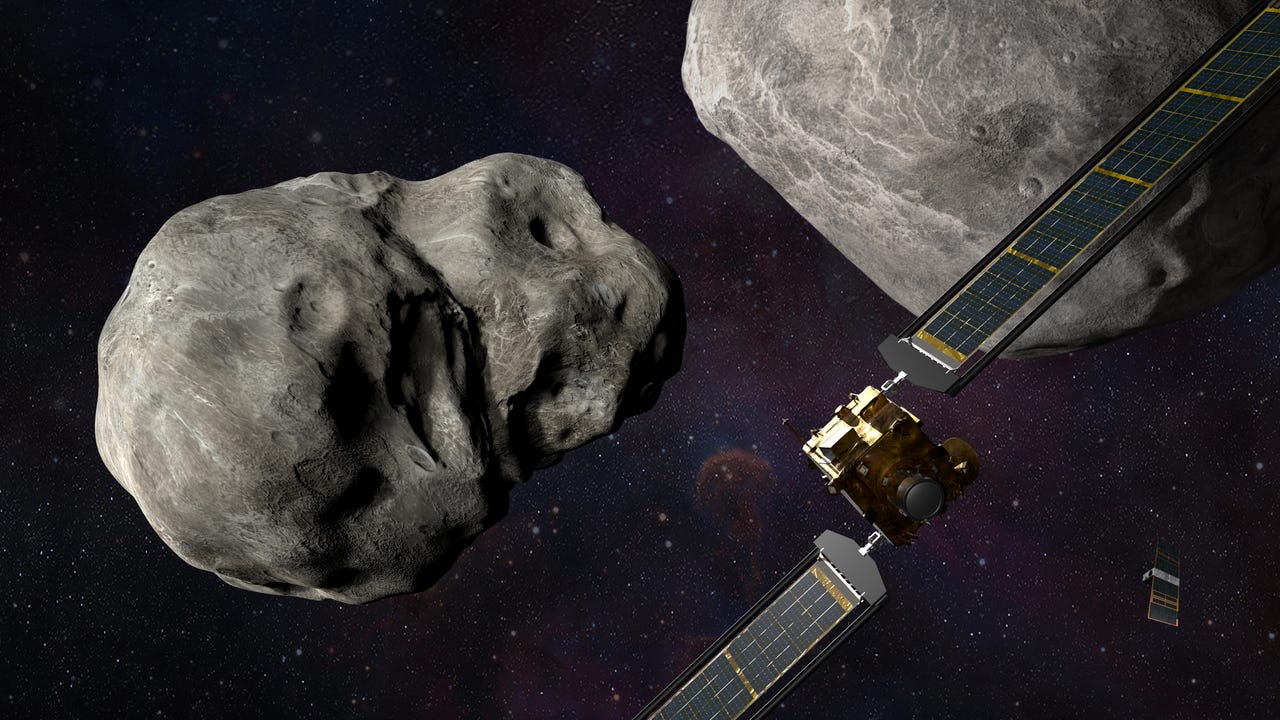
































The Double Asteroid Redirection Test (DART) will help determine if intentionally crashing a spacecraft into an asteroid is an effective way to change its course.
Image: NASAAlthough it might sound like a new level of Space Invaders, NASA is launching a spacecraft to collide with an asteroid. The aim of the Double Asteroid Redirection Test (DART) mission on September 26 is to change the asteroid's trajectory. The DART mission is meant to test the technology that could defend Earth from being struck by potential asteroid or comet hazards in the future -basically to avoid a repeat of the dinosaur situation.
The DART spacecraft is targeting Dimorphos, a moon orbiting the near-Earth asteroid Didymos -an object that does NOT pose any threat to Earth. Once the spacecraft reaches its 530-foot (160 meters) diameter target, the goal is to change the asteroid's speed and path.
The spacecraft will carry a sophisticated guidance, navigation, and control system, called Small-body Maneuvering Autonomous Real Time Navigation (SMART Nav), which will enable it to identify and distinguish between the two asteroids, according to NASA.
SEE:What is Artemis? Everything you need to know about NASA's new moon mission
DART is part of NASA's planetary defense strategy, managed by the Johns Hopkins Applied Physics Laboratory (APL) in Laurel, Maryland.
Although Dimorphos poses no threat to Earth, changing its course will help the DART Investigation Team determine the reliability of the approach, assess how best to apply it to future planetary defense scenarios, and determine how accurate the computer simulations are and how well they reflect the behavior of a real asteroid, says NASA.
"DART is turning science fiction into science fact and is a testament to NASA's proactivity and innovation for the benefit of all," said NASA administrator Bill Nelson in a blogpost. "In addition to all the ways NASA studies our universe and our home planet, we're also working to protect that home, and this test will help prove out one viable way to protect our planet from a hazardous asteroid should one ever be discovered that is headed toward Earth."
To see how much the asteroid actually moves, the team will be looking at telescopes from Earth, including using the James Webb Space Telescope (JWST), Hubble Space Telescope and Lucy Space Probe to do this monitoring.
The European Space Agency's (ESA) Hera mission will help gather even more data about the kinetic impact. Hera is scheduled to launch October 24, two years after the collision. Once launched, Hera will perform a detailed post-impact survey of the target asteroid, Dimorphos, according to ESA.
During the DART mission, NASA will be livestreaming images on NASA TV -Didymos Reconnaissance and Asteroid Camera for Optical navigation (DRACO) images will reach Earth at a rate of one per second. The DART launch date is September 26 and the collision is set to occur at 7:44 PM ET. However, the livestreaming will begin at 6 PM ET. In a press briefing Monday, NASA reassured its audience that the images will be "something spectacular".
The Double Asteroid Redirection Test (DART) mission is NASA's planned spacecraft collision with the Dimorphos asteroid to change its course. This collision will test the technology that could defend Earth from being struck by potential asteroid or comet hazards in the future.
A successful test will provide NASA with the confidence that deflection tech could work in the future with potential asteroid or comet threats. The data collected will come together to validate the scientific model and provide further insight to future attempts at asteroid deflection.
During a NASA briefing on Sept 12, NASA reassured its audience that there are only four 10km asteroids NASA has identified and is actively tracking. None of these large asteroids are a threat to Earth at the moment.
There have been so many simulations in varying conditions that NASA is very confident it will hit its target successfully, said NASA in a briefing on September 12. The impact won't disrupt the asteroid, it won't blow it up, it will simply change its course, NASA added. There is no scenario in which one or the other asteroid can become a threat to Earth. Nancy Chabot, DART coordination lead, even compared it to "running a golf cart into a great pyramid".
Overall, NASA is unaware of any objects currently threatening Earth. However, there is a possibility that in the future there will be one that threatens the Earth, so we need to have the technology ready.
Both launches will be just as successful -an overlap on dates between the Artemis and DART missions is not likely to cause any problems to either mission.
Yes, the Didymos Reconnaissance and Asteroid Camera for Optical navigation (DRACO) will send images to Earth at one per second, which will be streamed live on NASA TV. The livestream will begin at 6:00 PM ET on September 26, with the collision expected to take place at 7:14 PM ET.
 Горячие метки:
3. Инновации
1. Космос
Горячие метки:
3. Инновации
1. Космос